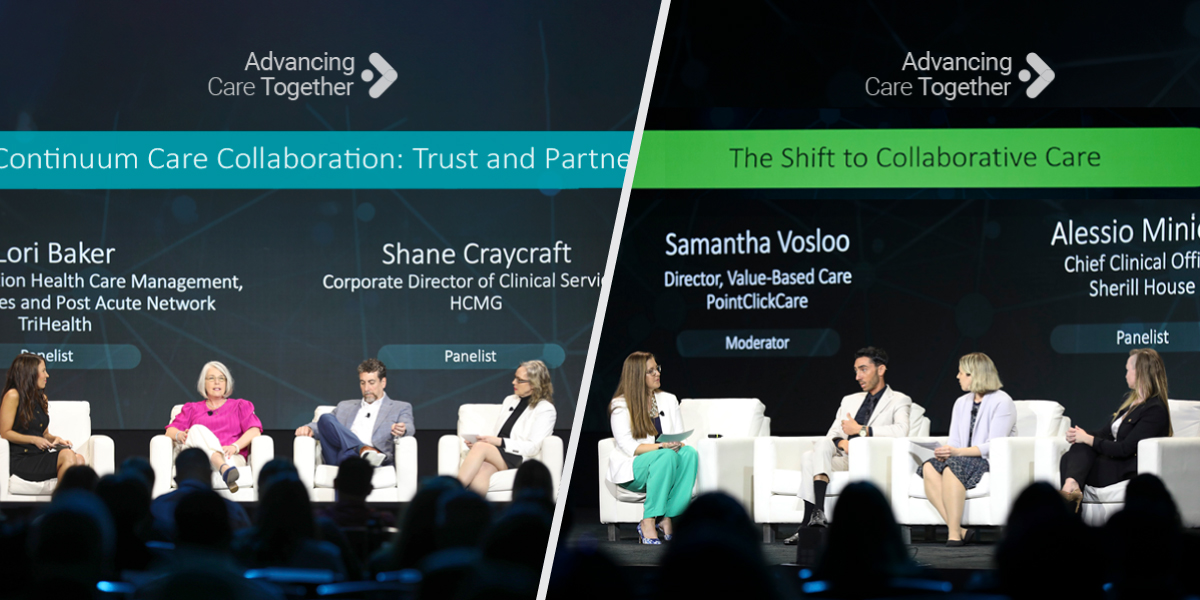The shift toward collaborative care models is gaining momentum, promising better outcomes and patient experiences. At PointClickCare, we’ve witnessed the transformative power of collaboration firsthand.
Our recent SUMMIT user conference serves as a testament to this statement. When we brought our customers to the main stage for the first time to share how collaborative care, coupled with innovative technology, is driving quality outcomes across the industry. Two of our panel sessions, “The Shift to Collaborative Care” and “Cross-Continuum Care Collaboration,” showcased the positive results our customers have experienced from leveraging partnerships to improve healthcare.
Why Is the Collaborative Care Model Gaining Traction?
With more than 50% of all Medicare patients now covered under value-based care (VBC) arrangements, the imperative for collaboration has never been clearer. These payment models prioritize quality over quantity, compelling providers to work together toward shared goals of improving patient outcomes while containing costs. The collaborative approach not only fosters better clinical outcomes but also drives revenue growth and enhances customer satisfaction.
What Are the Key Market Trends Driving Collaborative Care?
During SUMMIT, our panelists identified the most significant market dynamics driving the shift towards collaborative care. Outcomes and quality care stood out for Kristin Thrun, VP of Operations at Community Physicians: “I think the biggest changes we have seen have really been with the alignment of outcomes and quality measures across the care continuum. We’ve seen them in SNFs (skilled nursing facilities) and now even in home health, and we’re not only seeing it with rehospitalization but the expansion of the quality measures.”
“The availability of more technology and shared information play a huge role in supporting the collaborative care model,” added Alessio Miniello, Chief Clinical Officer at Sherrill House. “I think at the center of that is always going to be information — how it’s documented and how it’s shared throughout the continuum. The other thing is realizing that, although we’re so competitive in this business, we only play one small piece in every patient journey, and we’ve got to do that collaboratively,” he continued.
Why Have PointClickCare Customers Adopted the Collaborative Care Model?
Our customers recognize the pivotal role of collaborative care in shaping the future of healthcare. Miniello emphasized the importance of early adoption to better prepare facilities for the future. “I think we’ve all learned post-pandemic that if you feel that this doesn’t apply to you right now and you’re waiting for the ball to drop before implementing it, doing it under more stressful situations doesn’t bring good results. So starting as early as possible is key,” he said.
Kristin pointed out that the collaborative care model and the PAC Management tools PointClickCare provides allow facilities to create a full picture of their post-acute care data. “I think that PointClickCare’s tools give us an opportunity to take charge of our data, look at the opportunities, and then figure out how we can now partner together to improve outcomes,” she said.
For Emily Vazquez, VP Special Operations at CareOne, collaborative care is linked to the reason many healthcare professionals join the industry in the first place. “We have the opportunity to give back to the patients and I think that’s something that people have to consider. Being part of this is being part of changing healthcare. So why not do it first?”
What Are the Tangible Outcomes of Collaborative Care?
The impact of collaborative care initiatives is tangible and far-reaching. Shane Craycraft, Corporate Director of Clinical Services at HCMG, cited a dramatic drop in rehospitalizations in his network as an example. “We now have an opportunity to recreate all the quality measures to redefine what they really mean and where they should be,” he said. “We’re excited about that. If we look at it from the perspective of rehospitalizations, what other quality measures can we tackle together?”
Similarly, Lori Baker, Director of Population Health Care Management, Senior Services, and Post-Acute Network at TriHealth, noted that their patients’ length of stay has decreased significantly. Medicare patients went from a 25-day length of stay and a readmission rate of 25% to an 18-day length of stay and a readmission rate of 8%. “That’s truly the work of partnership and collaboration. I think that’s really what PAC Management has done to help us support taking care of the patient,” she said.
At Southcoast, collaborative care efforts allowed the health system to streamline the management of SNF placements. By centralizing SNF placements under a dedicated team of specialty nurses, Southcoast achieved remarkable reductions in length of stay, enhancing the overall care experience for patients. “We decreased the length of stay for discharge to SNF in our hospitals by 2.2 days, which is phenomenal,” shared Patricia Buiocchi, Senior Vice President of Post-Acute Care.
Empowering Collaborative Care
It’s clear from our customer panelists that collaborative care is shaping the future of healthcare. Through events like SUMMIT and the frequent Care Collaboration Conferences we host across the U.S., we’re creating a platform for meaningful discussion and a space where providers can find value in shared experiences.
Through these ongoing discussions, the employment of technology-driven solutions, and a collective commitment to patient-centric care, PointClickCare and the customers we work with are spearheading a paradigm shift towards better outcomes and enhanced patient experiences. Together, we are charting a course toward a brighter, healthier future for healthcare delivery — one built on collaboration, innovation, and unwavering dedication to improving patient lives.
Where to Next?
Join a Care Collaboration Conference near you and be part of the conversation about how we can solve some of healthcare’s biggest challenges together. Check out our calendar of upcoming events and click on the event nearest you to register and learn more.







